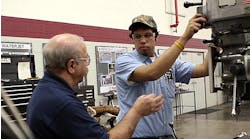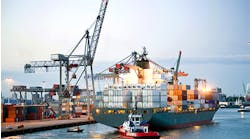Foundries soon may face the same air pollution requirements imposed on the power generating industry. As in the power industry, emissions will be a topic of concern, because coal fuel is becoming growing in industrial use: it is easily transported and costs only about three dollars to generate a million Btus, compared with more than $7 for natural gas or oil, according to the U.S. Energy Information Administration. But, coal-related emissions are blamed for much of the U.S. power and manufacturing industries’ nitrogen oxide (NOx), sulfur dioxide (SO2), and mercury emissions. The head of the U.S. Environmental Protection Agency predicted that the power industry, to meet the Clear Skies Act, would spend more than $50 billion on new air pollution equipment over the next 10 years.
In that light, it seems like just a matter of time before the EPA begins to impose the same requirements on the foundry industry. Estimates put the cost for moderately sized, foundry air-pollution control system as high as one million dollars. So, it will be important and necessary for the industry to understand a bid-price if they want to remain profitable. Do foundries understand how to evaluate a bid?
Pricing formula—Cash flow and profitability are determined by money management, cost control, and the ability to recognize profits unseen by ordinary bookkeeping. What appears to be a low or high price may be something much more complicated. A price must be evaluated according to a formula that considers cash flow and terms of payment in connection to the dollars in the bid-price. This recognition of cash flow, and close attention to the terms of payment must be part of any evaluation of a bid-price.
Planning for air-pollution controls (in terms of material and/or labor) requires understanding of marketing strategy, engineering, manufacturing, and labor costs, and the proper structuring of the bid price. Major capital projects should never be approached as “cost plus markup,” as is the standard for off-the-shelf goods. Both the bidding contractor and the buyer must carefully study the bid-price. This means understanding the four rules of bidding:
Rule 1: A bid-price being offered should be based on an achievable performance.
Rule 2: A bid-price should always reflect the “conditions” of the day.
Rule 3: A bid-price should recognize design considerations.
Rule 4: A bid-price should consider the customer’s financial position.
Observing the fourth rule also means asking tough questions, such as: Does the bidder recognize cash-flow as a profit or loss item? Does the potential customer or bidder recognize cash-flow, and do they have a cash flow problem? Does the bidder have a cash-flow problem?
The best way to proceed is to use other people’s money, but how? The answer lies in the “terms of payment and billing.” Depending on the size of the project, payment terms can be set several ways, such as: 1) As a percent on order, 2) as a percent on shipments, 3) as a percent on completion, 4) as a guaranteed retention, 5) all up front, and finally, 6) all on completion.
Each of these terms of payment alters the bid-price (Remember that a “bid-price” is given, or accepted, on a real project that is to be completed in a specified time period and tied to a pre-determined set of terms and conditions).
Cost, and perception—First, it is important to understand the cost and how it can be perceived, starting from the bid stage to the actual contract work. Cost is the sum total of the fixed and variable expenses to manufacture a product. Fixed costs cover the expense of running a business (rent, utilities, office equipment, insurance, salaries, depreciation, and property taxes). Variable costs include raw materials, hourly wages paid to laborers and contractors, warehousing and shipping costs, and manufacturing efficiencies (efficiencies covering shop loading, employee attitudes, and the use of new or antiquated equipment). Once evaluated, these variable costs, especially labor, become a static value for a semi-annual or annual period. This may cause a current spike in costs for a project that spans years to complete. At any time along the way costs and profits could vary, depending upon how cost (and profit) are perceived.
Therefore, a cost must be established or defined that will include (or be based upon) the expected attainable efficiency of operation (i.e. the number of brick laid per man, square foot per day for installing insulation or lagging, etc.) This cost should be related to the project time frame.
Terms of payment, and cash flow—Once the cost (and bid-price) have been established, the terms of payment and cash flow over the span of the contract must be considered. In these days of low interest rates, cash flow may not seem so great, but even a small percentage change in the price can affect the outcome of a bid. As such, it will be critical to know or establish percentages of completion over time.
To repeat, it is best to use other people’s money, e.g., having the customer pay as the project proceeds. Rather than dealing in dollar amounts, it will be easier to use percentages to determine how a bid price and payments will flow. First, there is up-front engineering cost (perhaps 10% of the total), followed by material purchasing at different points of the project time line (20%), then shop costs (15%), and field labor costs (25%) that must be considered. Remember that it’s important to consider how the customer will perceive a bid price when establishing terms of payment and cash flow. Consider: 1) Can the bid-price appear too low to the customer because of the upfront money? 2) Does the customer evaluate terms of payment in deciding who gets the award? 3) Does the customer recognize the differences and effects on the bid-price due to different payment terms?
Once the costs over the project’s duration have been established, it’s possible to chart the cost of money or cash flow that must be recovered during the contract period. Table 1 details a lagging and insulation project spanning 12 months and using a flat percentage of the total cost:
This table, then, would then be a basis for cost of money or cash flow that could be compared to the cash flow as recovered, based on the project’s terms of payment (i.e. percent on order, percentage on shipments, percentage on completion, guarantee retentions, all up front, or all on completion.) For example (see Table 2):
- Customer pays 100% up front, assuming 6% interest: the cost of money is 6%/1,2003(682-1,200), resulting in a 2.59% reduction in bid price. Or,
- Customer pays 100% upon completion, assuming a 6% interest rate: the cost of money is 6%/1,2003(682-100) resulting in 2.91% added to the bid price.
Having separately developed a bid-price for the project ($100,000) based on the standard cash flow, this bid-price can be modified to reflect the terms of payment being negotiated or desired (see Table 2.) For this reason, a base bid-price should always take into account the cost of money (cash flow).
Once a base bid-price has been established it can be altered to appear more attractive (lowered to reflect a positive cash flow i.e. 100% upon order) or adjusted to reflect terms of payment requested by the customer (i.e. 100% upon completion). There are many reasons for adjusting the terms of payment. For example, the customer may desire to pay a percentage up-front because of a tax issue and pay a percentage on completion due to his own internal cash flow problems.
Clear skies ahead—Soon, foundries may have to comply with the Clear Skies Act, just as power generators will be required to spend billions of dollars on air-pollution control equipment. Whether one is the bidder or the customer awarding a contract for a large air-pollution control system or new foundry equipment (i.e. new rotary kiln), understanding the bid-price is an essential business survival strategy. Understanding cash flow and evaluating the terms of payment are equally important when understanding the four rules of bidding. Cash flow and profitability are all about money management, cost control, and the ability to recognize profits. When metalcasters begin to recognize and understand what a low bid-price is, everyone wins — and stays profitable.








